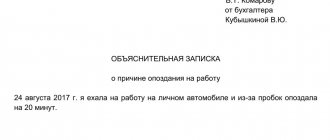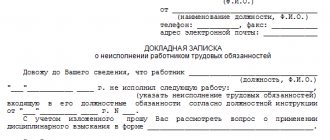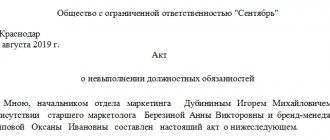Internal information is disseminated using special information and reference documents, one type of which is a memorandum. It is addressed to people holding higher positions in order to inform them of certain facts in order to encourage them to make a certain decision.
Examples of memos:
- violation of labor discipline (absenteeism) - failure to fulfill official duties - unacceptable behavior of an employee
A memorandum as an internal document has certain principles of drafting, depending on its purpose. We will reveal exactly how reports should be drawn up in certain work situations.
- Form and sample
- Free download
- Online viewing
- Expert tested
FILES
Specifics of the report
This type of official information, unlike other types of notes, is addressed exclusively to higher positions, authorized persons, superiors - that is, people who make real decisions. The information contained in such a note is precisely intended to bring to life some kind of action, which one depends on the purpose of the report and the information and proposals contained in it.
Difference from a memo
The report is intended to convey information “vertically”, and the memo transmits information between employees of equal status. Unlike a report, a memo is not provided for by OKUD. Written by the employee of his own free will.
Difference from an explanatory note
The explanatory note is also sent “vertically”, but is fundamentally different in the purpose stated in the very title of the document: to explain this or that current situation in order to resolve the issue of the employee’s guilt or innocence. That is, as in the report, a representative of a higher position is encouraged to make a decision, but this decision concerns only disciplinary violations. OKUD has its own code, just like the report. Written at the request of management.
NOTE! The memorandum, depending on the circumstances, can be written on one’s own initiative or at the direction of authorized persons. This document has legal force.
Duration and place of storage
After the problems outlined in the memo are resolved, it is sent for storage. You can store it in the following places:
- file it in a book where all the grounds for orders are collected (applications, memos, certificates, etc.);
- file with the documents that were drawn up on the basis of this report (internal investigation, order, etc.).
The storage period for the memorandum will depend on what documents will be compiled as a result. On average, this period ranges from 3 to 5 years. Therefore, the folder where all the memos are stored can not be stapled, but simply stored in a binder.
Functions of memos
The main purpose of reports is to inform management and encourage further action. The specific functions that a memorandum can perform may be different:
- resolving a problem of a production or administrative nature;
- rationalization proposals for improving production activities;
- conveying to management an opinion on the decision made (most often this is how disagreement is expressed);
- explaining your position in the event of a conflict with colleagues or immediate superiors;
- regular progress reports;
- complaints in case of employees’ refusal to carry out the orders of their immediate superiors;
- proceedings regarding improper delegation of responsibilities;
- bringing to the attention of management information about violations of labor discipline and regulations;
- information about incidents that resulted or could result in material loss or physical harm;
- positive aspects that require management's reaction.
In what cases is it used?
A memorandum is written in cases when it is necessary to convey information to higher management:
- about violation by employees of labor discipline or job description;
- about violations that have occurred, decisions on which can only be made by the manager.
In other words, it is informational in nature and assumes that the further course of action is determined by senior management.
Classification of memos
If we consider this type of official documentation from different positions, we can identify several of the most frequently used types of reports.
- Content. Depending on what information the report contains, we can distinguish:
- informing - conveying to the authorities the information necessary for making a decision, for example, about the progress of work, about the nuances that have arisen, and methods of action; as a rule, submitted regularly until the completion of the project;
- reporting – reports on the completion of any stage of work to receive further instructions and, if necessary, normalize the situation;
- proactive - the author makes his proposals based on the information he provides.
- Destination. Its type depends on who exactly the report is sent to:
- external - sent to the management of another institution;
- internal – addressed to higher-ups within the organization.
- Data. Information brought to the attention of management that requires immediate action is often negative. But it happens that you need to notify your superiors about the employee’s special successes. The type of report depends on the situation described in it:
- violation of labor regulations and discipline;
- failure to perform or insufficient performance of official duties;
- allowing insults to honor and dignity, unacceptable behavior, provoking conflicts;
- outstanding achievements worthy of awards, etc.
FOR YOUR INFORMATION! Internal and external reports are characterized by a significant difference in design: for the latter, the organization’s form is required.
What types does it have and its purpose?
In the course of work, any employee of the organization can record the fact that some of his colleagues perform the duties assigned to them by their positions carelessly. And based on this fact, draw up a so-called memo. To compile it, either a sample accepted at the enterprise is taken or a free form is used.
This action is aimed at recording the fact that a violation of internal labor regulations has occurred. They may be as follows:
- Is systematically late without good reason;
- Also constantly leaves before the due date;
- Absenteeism;
- Showed up drunk;
- Fails to perform job duties correctly;
- Inactive. The consequences of this may be negative for the company or other employees;
- Communicates incorrectly with co-workers.
This message to superiors can be used both internally and externally. This allows us to divide into two types:
- Internal. This option is the most common for reporting to superiors the fact of incorrect performance of job duties. Typically, the company's letterhead is used for such purposes. For certification, the signature of colleagues who witnessed what is happening is enough;
- External. The certificate goes beyond the boundaries of the company, since it is drawn up in the name of either representatives of control authorities or the head of the head office. Typically, the reason for drawing up this paper is the incorrect actions of one’s management, which must be reported to a higher authority.
The form for compiling both papers is almost the same, the only difference is that the external form must be certified not only with signatures, but also with the company’s seal.
According to experts, the main thing in this paper is the evidence base and the need to defend one’s words.
Author of the report
Theoretically, any employee of the organization has the right to write a memo. In practice, when presenting it, the principle of subordination is observed. The head of a structural unit writes a report addressed to the general director. Subordinate employees must resolve situations that arise first with their immediate superiors. And if it deems it necessary, it will bring the information to the attention of the management. It is acceptable to apply directly, but then the report must be endorsed by the immediate supervisor.
The exception is the case when the memo is drawn up in connection with a complaint against the head of the structural unit himself. In such cases, any employee can directly appeal to senior management.
Are there any special features of the report?
There is a difference in how a memo is formatted compared to an official memorandum. The main difference is the direction:
- reports are addressed vertically: from the subordinate upward;
- official ones are sent in parallel - between employees who are not directly subordinate.
| Internal memos are exclusively an internal document; they are written in free form, while memos can be sent to other organizations. |
How to write a report correctly
Regardless of what type the report belongs to, there are certain points in the structure that must be observed. As a rule, a report can be divided into three independent parts.
- Facts, events, reasons that prompted you to write a report. This part should give the reader an answer to the question “What happened?”
- The author's thoughts on the current situation, his suggestions, options for possible solutions.
- Conclusions and recommendations of the author of the note.
Recommendations for design
Like any business document, a memorandum must fundamentally comply with the requirements set out in GOST 6.30–2003 “Unified documentation systems. Unified system of organizational and administrative documentation. Documentation requirements."
IMPORTANT! If this document is drawn up incorrectly, it may be considered legally unreliable and, thus, will lose the force of evidence when resolving controversial issues.
We prepare an internal report
The internal memorandum can be written or printed on a regular A4 sheet. No special form is required for this. Details that are accepted for this type of internal documentation:
- the name of the unit addressing the note is located in the upper left corner;
- the recipient of the note - his full name (initials are enough) and position must be indicated in the upper right corner;
- the title of the document in capital letters in the middle of the sheet - REPORT NOTE (location on the left edge of the sheet margin is allowed);
- below is the date in the format dd.mm.yyyy in Arabic numerals - this is the day the document was signed;
- short summary of the report;
- content in three separate blocks;
- on the last line the signature of the author is placed with a transcript and the title of the position.
Features of the design of an external report
An external memo is an outgoing document. It must be drawn up on the organization’s letterhead. In addition to the information listed above, the external report must contain the following information:
- information about the sending organization;
- number assigned to the document;
- the city in which the report was compiled;
- subtitle (written below the title of the document and begins with the words “Regarding...” or “About...”).
The remaining elements - the title of the document, the addressee's data, the text of the report, the signature of the author - are drawn up in the same way as in the internal report.
Compilation rules
Not a single regulatory act provides a sample of how to write a memo to an employee. But OKUD has a form under code 0286041 - this is a report on violation of labor discipline, which is used by clerks and secretaries when registering disciplinary sanctions. So it is an official document for internal or external use and certain rules must be followed while forming it.
When drawing up, it indicates:
- in the header - company name, full name. and the position of the addressee (most often written in the name of the director, but there are other options), full name. and the position of the compiler;
- below is the title of the document - a report on truancy (other violation, incident). It is recommended to write the first two words in capital letters, and the continuation in small letters below. There is no need to put a period at the end;
- The main text usually begins with the phrase: “I bring to your attention the following information.” But this is not necessary, the document is drawn up in free form, and improvisation is allowed. The main thing is that the essence is clear. In addition to a detailed description of the situation, the compiler asks management to influence the situation. If we are talking about the fact that a certain employee Ivanov is regularly late, you can ask to influence the negligent colleague by issuing a reprimand or reducing bonus payments, if such a method of influence is provided for in the employer’s LNA;
- the final part contains the signature and transcript of the originator, the date of circulation. Remember that the compiler can be one person or a group of colleagues. If the complaint is collective, everyone signs it.
Since the sample of how to write a memo for an employee has not been approved, there are no requirements for whether it should be written by hand or typed. Whatever option you choose, follow the general rule - the document is signed personally by the originator. The remaining nuances are secondary.
Before showing examples of how to write a memo to a manager, let us remind you about GOST R 7.0.97-2016, which regulates the requirements for document preparation in 2021. It is voluntary and you do not have to follow its rules. But it has several important general rules:
- the document is drawn up on a regular A4 sheet;
- if the text takes up more than 2 pages, they are numbered and connected in some way;
- the name of the organization and full name of the addressee are indicated in the upper right part of the document (corner location of details) or on the right under the details of the form (longitudinal location of details);
- It is recommended to write the title of the document in full so that it answers the question “about what?”: for example: “Memorandum of dereliction of duty”;
- the date of compilation may be written in Arabic numerals or in a format like “September 30, 2021.”
If possible, attach documents confirming the stated facts. These are, for example, papers drawn up incorrectly by an employee. All this evidence will help when conducting an internal audit and making a decision to bring the negligent employee to justice.
Report on violation of labor discipline (absenteeism)
Such a document is an official confirmation of the employee’s disciplinary offense. In order for a disciplinary sanction to be imposed on him, management must be notified of the violation. This is why this type of report is used. It contains information about the offense and a request to take appropriate action.
Example of a report on violation of labor discipline
Human Resources Department General Director of Omega LLC N.V. Groshchenko
REPORT NO. 1
06.11.2016
Violation of labor discipline (absenteeism)
I hereby bring to the attention of management that the day before yesterday, November 4, 2016, an employee of the HR department, Tatyana Olegovna Valeryeva, committed a gross violation of labor discipline. After the lunch break, which ended at 14:00, she did not return to her workplace and was absent until the end of the working day (from 14:00 to 18:00). Supporting documents and satisfactory explanations for his absence T.O. Valerieva did not provide it over the next two days.
In connection with a gross violation of labor discipline, I propose to declare T.O. Valerieva is reprimanded and entered into her personal card.
Head of Human Resources (signature) R.V. Sukharevsky
Report on the employee’s failure to fulfill his official duties
This document is intended to convey to management information that the employee has improperly performed or has not performed his professional duties at all. The final document contains a request for disciplinary action. Without such a report, any sanctions against the employee may be considered unfounded.
Example of a memo on failure to fulfill official duties
Metrology Department General Director of Rosmashinstroy LLC Radkovsky K.L.
REPORT No. 2
October 15, 2016
Failure to fulfill official duties
With this document, I bring to your attention that the engineer of the metrology department, Anton Petrovich Reisfader, violated the schedule for checking electricity metering devices (he did not monitor the implementation of the approved schedule), which resulted in the imposition of a fine on the organization by the state inspector for control over metering devices.
In connection with the violation, I propose to declare A.P. Ricefader is reprimanded and will be included on his personal card, and no bonus will be given to him based on the results of his work for the next month.
Chief metrologist (signature) P.K. Zheltkovsky









